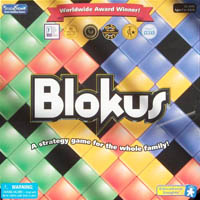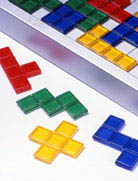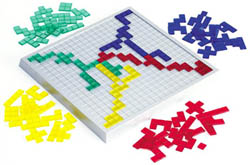
|
About OgreCave and its staff
|

|
by Lee Valentine
Blokus (pronounced "Block Us") is a tile-laying strategy board game designed to really test a player's spatial relations skills. The game is played on a grid, with the goal being to fit as many of your own shaped tiles onto the grid as possible while blocking your opponents' attempts to play their own pieces. Blokus is published by a company called Sekkoïa, which licenses publishing rights to other companies such as Educational Insights in the United States. Blokus was designed by French mathematician and scientist Bernard Tavitian.
Gameplay
Players take turns in color order (blue, yellow, red, and green) playing one piece at a time. Players continue playing in this fashion, skipping over any player who can no longer legally play. When all players can no longer play, the game is scored. Players start with a score of zero, and at the end of the game they lose one point for every sub-square on each of their pieces that they were unable to play. So, for example, if you were unable to play your domino (the two square piece) then you would lose two points. If a player plays all of his pieces, then he gets a 15 point bonus (instead of scoring zero). If a player plays all of his pieces and uses his monomino (his piece made up of just a single square) as his last play, then he gets another five points, making his round score 20 total points. Blokus is an oddity, in that it's one of the few games where the winner and the losers alike often have a negative score, but this is merely a result of the fact that you almost always have fewer pieces unplayed than played, so the counting is quicker by penalizing players for unplayed pieces than by counting played pieces.
The more, the merrier In three player mode, the game is played normally, except that the green pieces are owned by nobody. Players instead take turns playing a green piece whenever green is owed a turn. So, the turn order is blue, yellow, red, green (played by blue), blue, yellow, red, green (played by yellow), etc. In two player play, one player takes blue and red, and the other player takes yellow and green. Each player plays a piece of the appropriate color in the normal blue, yellow, red, and green turn order. When the game is over, each player computes the score for each of his colors separately and then sums up the scores of the two colors he was playing. Blokus can even be played with four players in teams of two, with each player taking one color and adding his score at the end of the game to his partner's score to determine a team score. In all modes of play except the two player mode of play, it is possible for an inexperienced neighboring opponent to get so carried away with thwarting your moves that he ends up hurting both you and himself. I found this particularly true with the three player mode of play when I tried it, making me like three player Blokus substantially less than playing with two or four players. Sekkoïa manufactures another version of Blokus just for two players called Travel Blokus or Blokus Duo. Blokus Duo comes with only two colors of pieces, orange and violet. Unlike the two player version of the classic Blokus game, in Blokus Duo each player plays just one color, and plays on a 14 x 14 grid. Unlike classic Blokus, the starting squares for Blokus Duo are not the corners, but spaces five units in from the corner: one player must cover grid position (5,5) on his first move and the other player must cover grid position (10,10) on his first move. The game's rules are otherwise identical to Blokus. I mention Blokus Duo's rules here, because it is entirely possible for two players to mark off a corner of a classic Blokus board and to play using the Blokus Duo rules. Blokus Duo is a very fast-paced game, and is worth experimenting with on a classic board.
Components
I also liked the storage materials Sekkoïa included. Each color has its own triangular storage tray, which means that when you cleanup, you are immediately ready to play the next time you open the box. The four triangular trays fit together flush in the box, on top of the board, and this keeps the pieces from moving around much during transport. That said, Blokus is a game that likes to be stored flat, and the contents might slip out if you tried to store the box sideways. As with your other games, consider using some plastic bags if you feel the need to store Blokus on its side or if you transport it around a lot. The rulebook itself is full color and is written in pretty clear language, although it does not address whether a player can "pass" if he can't figure out a play to make, and whether, if he passes, if he can resume play later when he figures out a legal move. As a result of this omission, some players can suffer analysis paralysis, exhausting every possible square on the board before declaring that they have no further moves they can make, and that can cause the game to stall occasionally.
Conclusions According to its publisher Sekkoïa, Blokus has been nominated for more than 25 distinct toy and game awards to date. That alone should tell you how good the game is, at least as a four player game. I found Blokus was also great as a two player game. As a three player game, however, it was merely good. But I did like the fact that the game scaled well all the way from two to four players. Most games in my collection that tend to be great for four players are lousy for two, and vice versa. This is a game that just about every gamer with a family should have in his collection. The pieces are a choking hazard for tiny tots, but for older children, this is a great way to build up their spatial relations skills while playing a really great game. If you would like to try Blokus before you buy it, Sekkoïa has created an online version of Blokus that you can play for free. They also recently licensed rights to create a version of Blokus that you can play solo against your computer, called Blokus World Tour, which costs $19.99, but which has a one hour free trial period. See my full review of Blokus World Tour for more information.
Lee's ratings: Links:
|
||||
 Blokus
Blokus There are four colors of pieces in Blokus: blue, yellow, red, and
green. In Blokus, each player is assigned a starting square and
set of 21 distinct polyominos of a specific color. Other than color,
each set of pieces is identical. A player's starting square is on a
designated corner of a 20 unit by 20 unit grid. The first piece played
by each player must cover his designated corner of the board. Each piece
played must fit entirely on the grid without overlapping any part of
another previously played piece. Each of your pieces after the first
must have at least one square of the new piece diagonally adjacent to a
square on one of your previously played pieces. However, no square of
any newly played piece can be orthogonally adjacent to any square on any
of your previously played pieces. There is no restriction about how your
pieces can be played relative to the pieces of other players, provided
that your pieces don't overlap theirs.
There are four colors of pieces in Blokus: blue, yellow, red, and
green. In Blokus, each player is assigned a starting square and
set of 21 distinct polyominos of a specific color. Other than color,
each set of pieces is identical. A player's starting square is on a
designated corner of a 20 unit by 20 unit grid. The first piece played
by each player must cover his designated corner of the board. Each piece
played must fit entirely on the grid without overlapping any part of
another previously played piece. Each of your pieces after the first
must have at least one square of the new piece diagonally adjacent to a
square on one of your previously played pieces. However, no square of
any newly played piece can be orthogonally adjacent to any square on any
of your previously played pieces. There is no restriction about how your
pieces can be played relative to the pieces of other players, provided
that your pieces don't overlap theirs.
 The polyomino pieces are colored transparent plastic which are
attractive and sturdy. The board is made of a sturdy plastic which will
survive heavy play. Being plastic, the game is a lot more friendly to
kids and adult gamers alike who are eating or drinking while playing. A
spilled cola might ruin your copy of Fury of Dracula, but will probably
just require a damp sponge to repair your copy of Blokus.
The polyomino pieces are colored transparent plastic which are
attractive and sturdy. The board is made of a sturdy plastic which will
survive heavy play. Being plastic, the game is a lot more friendly to
kids and adult gamers alike who are eating or drinking while playing. A
spilled cola might ruin your copy of Fury of Dracula, but will probably
just require a damp sponge to repair your copy of Blokus.